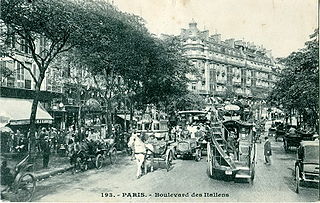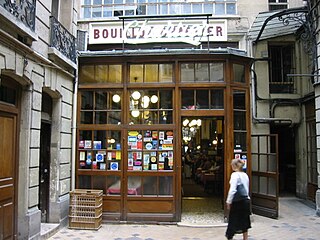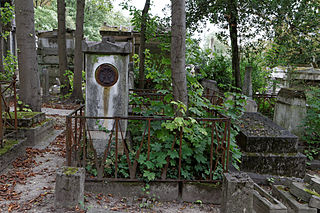
The 15th arrondissement of Paris is one of the 20 arrondissements of the capital city of France. In spoken French, it is referred to as le quinzième.

Gare d'Austerlitz, officially Paris Austerlitz, is one of the seven large Paris railway terminal stations. The station is located on the left bank of the Seine in the southeastern part of the city, in the 13th arrondissement. It is the start of the Paris–Bordeaux railway; the line to Toulouse is connected to this line. In 1997, the Ministry of Culture designated the Gare d'Austerlitz a historical monument; it became the fifth large railway station in Paris to receive such a label, as currently only Montparnasse has not been attributed it.

In France, Flanders, and the Francophone world, a brasserie is a type of French restaurant with a relaxed setting, which serves dishes and other meals.

The Boulevard Saint-Michel is one of the two major streets in the Latin Quarter of Paris, France, the other being the Boulevard Saint-Germain. It is a tree-lined boulevard which runs south from the Pont Saint-Michel on the Seine and Place Saint-Michel, crosses the Boulevard Saint-Germain and continues alongside the Sorbonne and the Jardin du Luxembourg, ending at the Place Camille Jullian just before the Port-Royal RER station and the Avenue de l'Observatoire. It was created by Baron Haussmann to run parallel to the Rue Saint-Jacques which marks the historical north-south axis of Paris. It is known colloquially as Boul'Mich' in French.

The Rue du Faubourg-Saint-Denis is a street in the 10th arrondissement of Paris. It crosses the arrondissement from north to south, linking the Porte Saint-Denis to La Chapelle Métro station and passing the Gare du Nord.

The Boulevard des Italiens is a boulevard in Paris. It is one of the 'Grands Boulevards' in Paris, a chain of boulevards built through the former course of the Wall of Charles V and the Louis XIII Wall, which were destroyed by the orders of Louis XIV. The origin of the name is the théâtre des Italiens built on it in 1783, shortly before the French Revolution on the site now occupied by the third Salle Favart.

Sèvres is a French commune in the southwestern suburbs of Paris. It is located 9.9 kilometres from the centre of Paris, in the Hauts-de-Seine department of the Île-de-France region. The commune, which had a population of 23,251 as of 2018, is known for its famous porcelain production at the Manufacture nationale de Sèvres, which was also where the Treaty of Sèvres (1920) was signed.

Bouillon Chartier, or simply Chartier, is a "bouillon" restaurant in Paris founded in 1896, located in the 9th arrondissement and classified as a monument historique since 1989.
This article presents the main landmarks in the city of Paris within administrative limits, divided by its 20 arrondissements. Landmarks located in the suburbs of Paris, outside of its administrative limits, while within the metropolitan area are not included in this article.
Laurent Vallon (1652-1724) was a French architect, mostly active in the Provence. Many of his buildings are now listed as monuments historiques.

Paris in the Belle Époque was a period in the history of the city during the years 1871 to 1914, from the beginning of the Third French Republic until the First World War. It saw the construction of the Eiffel Tower, the Paris Métro, the completion of the Paris Opera, and the beginning of the Basilica of Sacré-Cœur on Montmartre. Three lavish "universal expositions" in 1878, 1889, and 1900 brought millions of visitors to Paris to sample the latest innovations in commerce, art, and technology. Paris was the scene of the first public projection of a motion picture, and the birthplace of the Ballets Russes, Impressionism, and Modern Art.

The architecture of Paris created during the Belle Époque, between 1871 and the beginning of the First World War in 1914, was notable for its variety of different styles, from neo-Byzantine and neo-Gothic to classicism, Art Nouveau and Art Deco. It was also known for its lavish decoration and its imaginative use of both new and traditional materials, including iron, plate glass, colored tile and reinforced concrete. Notable buildings and structures of the period include the Eiffel Tower, the Grand Palais, the Théâtre des Champs-Élysées, the Gare de Lyon, the Bon Marché department store, and the entries of the stations of the Paris Metro designed by Hector Guimard.

Jacques Cellerier (1742–1814) was a French architect in the neoclassical style whose buildings can be seen mainly in Paris and Dijon.

Bouillon Julien, formerly Julien, is a brasserie-type restaurant in the 10th arrondissement of Paris, France. It was made an official Historical Monument for its Art Nouveau style.

La Fermette Marbeuf was a prestigious gourmet restaurant in the Champs-Élysées quarter in the 8th arrondissement of Paris, France. Its Belle Époque Art Nouveau "1900 room" has been an official Historical Monument since 1983. It now hosts the restaurant Beefbar.

Au Rocher de Cancale is a restaurant located in the 2nd arrondissement of Paris, France. It was very popular in the 19th century thanks to its suppers offered after theatre and opera shows.

The Closerie des Lilas is a famous Parisian restaurant located on the Boulevard du Montparnasse in the 6th arrondissement of Paris. It was opened in 1847 by François Bullier and was a simple brasserie at the beginning. Initially, it was named after a theatre piece called La Closerie des Genets by Frédéric Soulié. It progressively evolved into the Closerie des Lilas because its owner, Bullier, used to plant lilac flowers.

Le Select is a Parisian brasserie founded in 1923 in the 6th arrondissement at 99 Boulevard Montparnasse, in the Notre-Dame-des-Champs neighborhood. It was one of the more prominent meeting places of the Parisian intellectuals between the two world wars, with a significant place in the Bohemian Culture of the period.


















